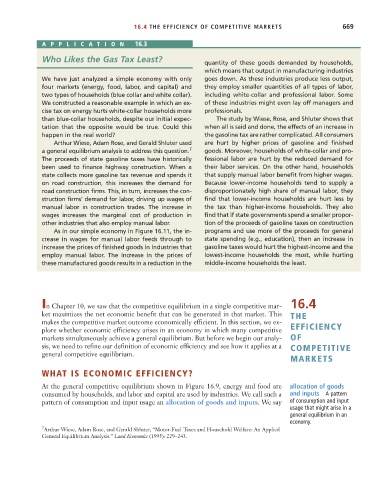Page 695 - Microeconomics, Fourth Edition
P. 695
c16GeneralEquilibriumTheory.qxd 8/16/10 9:13 PM Page 669
16.4 THE EFFICIENCY OF COMPETITIVE MARKETS 669
APPLICA TION 16.3
Who Likes the Gas Tax Least?
quantity of these goods demanded by households,
which means that output in manufacturing industries
We have just analyzed a simple economy with only goes down. As these industries produce less output,
four markets (energy, food, labor, and capital) and they employ smaller quantities of all types of labor,
two types of households (blue collar and white collar). including white-collar and professional labor. Some
We constructed a reasonable example in which an ex- of these industries might even lay off managers and
cise tax on energy hurts white-collar households more professionals.
than blue-collar households, despite our initial expec- The study by Wiese, Rose, and Shluter shows that
tation that the opposite would be true. Could this when all is said and done, the effects of an increase in
happen in the real world? the gasoline tax are rather complicated. All consumers
Arthur Wiese, Adam Rose, and Gerald Shluter used are hurt by higher prices of gasoline and finished
a general equilibrium analysis to address this question. 7 goods. Moreover, households of white-collar and pro-
The proceeds of state gasoline taxes have historically fessional labor are hurt by the reduced demand for
been used to finance highway construction. When a their labor services. On the other hand, households
state collects more gasoline tax revenue and spends it that supply manual labor benefit from higher wages.
on road construction, this increases the demand for Because lower-income households tend to supply a
road construction firms. This, in turn, increases the con- disproportionately high share of manual labor, they
struction firms’ demand for labor, driving up wages of find that lower-income households are hurt less by
manual labor in construction trades. The increase in the tax than higher-income households. They also
wages increases the marginal cost of production in find that if state governments spend a smaller propor-
other industries that also employ manual labor. tion of the proceeds of gasoline taxes on construction
As in our simple economy in Figure 16.11, the in- programs and use more of the proceeds for general
crease in wages for manual labor feeds through to state spending (e.g., education), then an increase in
increase the prices of finished goods in industries that gasoline taxes would hurt the highest-income and the
employ manual labor. The increase in the prices of lowest-income households the most, while hurting
these manufactured goods results in a reduction in the middle-income households the least.
In Chapter 10, we saw that the competitive equilibrium in a single competitive mar- 16.4
ket maximizes the net economic benefit that can be generated in that market. This THE
makes the competitive market outcome economically efficient. In this section, we ex-
plore whether economic efficiency arises in an economy in which many competitive EFFICIENCY
markets simultaneously achieve a general equilibrium. But before we begin our analy- OF
sis, we need to refine our definition of economic efficiency and see how it applies at a COMPETITIVE
general competitive equilibrium.
MARKETS
WHAT IS ECONOMIC EFFICIENCY?
At the general competitive equilibrium shown in Figure 16.9, energy and food are allocation of goods
consumed by households, and labor and capital are used by industries. We call such a and inputs A pattern
pattern of consumption and input usage an allocation of goods and inputs. We say of consumption and input
usage that might arise in a
general equilibrium in an
economy.
7 Arthur Wiese, Adam Rose, and Gerald Shluter, “Motor-Fuel Taxes and Household Welfare: An Applied
General Equilibrium Analysis.” Land Economics (1995): 229–243.

